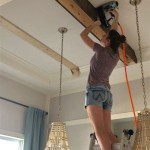How To Hang Fabric On The Ceiling
Hanging fabric from the ceiling can add a dramatic touch to any room. It can create a sense of intimacy, soften the look of a space, or even serve as a practical room divider. The process of hanging fabric from the ceiling requires careful planning and execution. This article will guide you through the steps of hanging fabric from the ceiling, ensuring a successful and aesthetically pleasing result.
1. Choosing The Right Fabric
The first step is to choose the right fabric. This choice will largely depend on the desired effect. Some common fabric choices for hanging from the ceiling include:
- Lightweight fabrics: These fabrics such as voile, chiffon, or sheer linen offer a delicate, airy, and ethereal look. They allow light to filter through, creating a soft, diffused ambiance.
- Medium-weight fabrics: Fabrics like cotton, silk, or satin can provide a more dramatic effect. They offer a richer texture and create a more defined shape.
- Heavy fabrics: Fabrics such as velvet, tapestry, or thick linen create a luxurious, dramatic feel. They tend to hold their shape well and can be used to define spaces.
Consider the intended use of the fabric. For example, if you are using the fabric as a room divider, choose a heavier material for better privacy and structure. If it's used for decorative purposes, a lighter fabric might be more suitable. Also, think about the aesthetic you're trying to achieve. Do you want a romantic and ethereal look, a modern and minimalist feel, or a bohemian and eclectic vibe? The fabric you choose should complement the overall design of the room.
2. Measuring And Planning
Once you've chosen your fabric, the next step is to measure and plan the installation.
- Determine the desired shape and size of the fabric: Will it be a simple drape, a canopy, or a more complex design? Measure the ceiling area where you want to hang the fabric and consider the desired length, width, and fullness of the fabric.
- Choose the hanging method: There are several options for hanging fabric from the ceiling, such as using rods, tracks, or tension wires. The choice will depend on the type of fabric and the look you're going for.
- Consider the weight of the fabric: Heavier fabrics may require stronger supports. Light fabrics might be easily hung using lighter hardware.
It’s always best to sketch out a rough plan to visualize the final result. This will help you determine the amount of fabric needed and the type of hardware required.
3. Preparing For Installation
Before you begin hanging the fabric, prepare the area and the fabric.
- Prepare the fabric: Wash and iron the fabric to ensure it is clean and free of wrinkles. If the fabric is very delicate, you can consider dry cleaning it instead. You may also want to pre-treat the fabric with a fabric sealant to make it less prone to stains and to protect it from fading.
- Prepare the ceiling: Ensure the ceiling is clean and free of any debris. If you're using a track system, mark the ceiling for the track’s placement. The markings should be precise and accurate to ensure a straight and even installation.
- Gather all the necessary tools and materials: This may include a drill, screwdriver, level, measuring tape, pencil, safety glasses, and the chosen hanging hardware. For delicate fabrics, you may also need a tailor's chalk or a fabric marker.
Having all the necessary materials and tools readily available will ensure a smooth and efficient installation process.
4. Installing the Fabric
The installation process will vary depending on the hanging method chosen. Here are some common methods for hanging fabric from the ceiling:
Using Rods
For this method, you will need decorative or plain rods, brackets, and curtain rings.
- Install the brackets: Mark the ceiling for the bracket placement using a level. Drill pilot holes and install the brackets, making sure they are securely attached.
- Attach the rod: Slide the rod into the brackets and secure it. You can use a decorative finial on each end of the rod for a polished look.
- Hang the fabric: Thread the fabric through curtain rings and then hang the rings onto the rod.
When using rods, consider the weight of the fabric. For heavier fabrics, use stronger brackets and a sturdier rod to ensure stability. Also, ensure the rod is long enough to accommodate the fabric's width and the desired fullness.
Using Tracks
Track systems offer versatility and are ideal for hanging multiple panels of fabric or for creating a layering effect.
- Install the track: Securely attach the track to the ceiling using screws or nails. Ensure the track is level and aligned with the desired layout.
- Attach the fabric: Insert clips or hooks into the track and then hang the fabric. The track system allows you to easily adjust the fabric's position and create different folds and drapes.
Track systems are particularly advantageous when hanging large pieces of fabric or when you need the flexibility to adjust the fabric's position. They are also generally easier to install than other methods.
Using Tension Wires
This method creates a clean and minimalist look, particularly suitable for lighter fabrics.
- Install the tension wires: Securely attach the tension wires to the ceiling using hooks or brackets. Make sure the wires are taut and level before you hang the fabric.
- Attach the fabric: Use fabric clips or rings to secure the fabric to the tension wires. This allows you to easily adjust the fabric's position and create different drapes and folds.
Tension wires are an excellent choice when you want a clean, modern look. However, make sure that the chosen wire material is strong enough to support the weight of the fabric.
5. Finishing Touches
Once the fabric is hung, you can add finishing touches to complete the look. This includes:
- Adjust the fabric: Adjust the fabric to achieve the desired drape and fullness. Consider the fabric's weight: heavier fabrics will naturally drape more beautifully. For lighter fabrics, consider adding weights to the bottom hem to create a more defined drape.
- Add embellishments: You can add embellishments to the fabric, such as tassels, fringe, or beads, to further enhance the look.
- Consider lighting: Consider how lighting will affect the fabric. Light will highlight the fabric’s texture and create a warm or cool ambiance.

Ceiling D Diy Tutorial

Ceiling Fabric D Add A Majestic Touch At Your Venue Canvas Etc

Ceiling Fabric D Add A Majestic Touch At Your Venue Canvas Etc

Wedding Ceiling D Fabric Ideas Hanging Kit 25

Beautiful Ceiling Makeover Diy Fabric Waved Style Tutorial

Ceiling Fabric D Add A Majestic Touch At Your Venue Canvas Etc

How To Hang Ceiling D Kit For Budget Wedding

Hanging Fabric Art Installation

Diy Ceiling D On A Budget Easy Tutorial

Hanging Fabric From Ceiling Ideas
Related Posts








